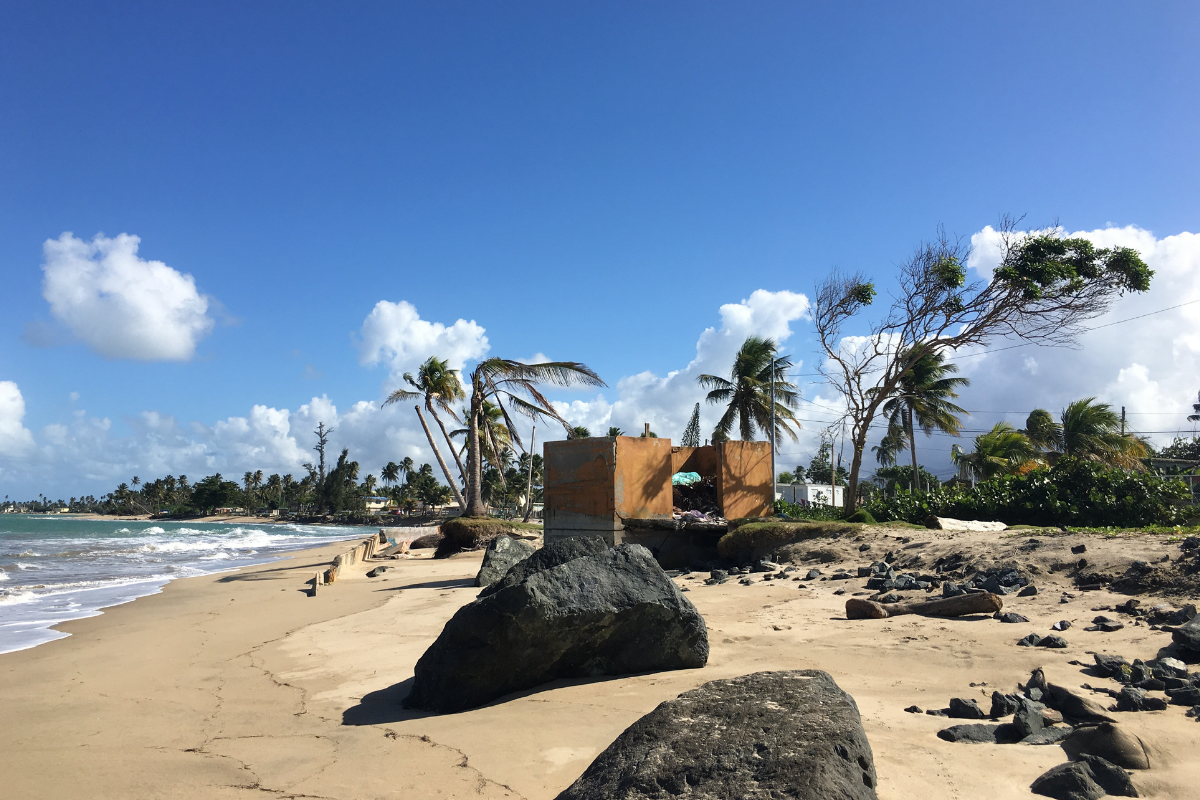

Erosion on the beach at Parcelas Suárez. (Photo by Kari Lydersen)
By Kari Lydersen, Isabel Dieppa and Martha Bayne
LOÍZA, Puerto Rico — Standing on the windswept beach, Guillermo Carmona looked out at the white-capped cerulean blue ocean and the hulk of a building that was once a beloved community center hosting town meetings and dances. Today, its scalloped roof slumps and its walls are pocked with gaping holes. The floor is littered with broken glass, sea bird droppings and trash. Nearby buildings are similarly decrepit; they once housed a fish market and an early childhood education program.
The structures are victims of Hurricanes Irma and María and —before that— the island’s struggling economy, forces that have devastated the homes and lives of many residents in this small community of Parcelas Suárez and across the island.
Many wealthier areas, like beachfront San Juan neighborhoods just 15 miles west, have rebuilt and even prospered since the hurricanes.
But the largely Afro-Caribbean community of Parcelas Suárez is starved of economic resources and faces another major challenge: drastic coastal erosion from strong Atlantic currents, made worse by sea-level rise and increasingly strong storms linked to climate change.
The beach alongside the destroyed community center is scarred by the relentless sea. Palm trees tilt toward the water, their roots naked and dangling. Concrete benches and picnic tables are crumbling, used only as shade by stray dogs. Carmona and other locals had hoped to rebuild the community center, originally opened in 1976 by a popular former mayor. But the building’s current state, the encroaching sea and the scarcity of money make that goal seem distant.
The Army Corps of Engineers is planning to build a 10-foot-high barrier of rocks to protect a 1,050-foot stretch of coast including the former community center, at a cost of $5 million in federal dollars. Erosion has been eating away at the beach since long before Hurricanes Irma and María, and since 2010, the Army Corps has been studying ways to curb the destruction. It studied “hard” options like a rock barrier and “soft” solutions like new dunes and vegetation. Scientists worldwide generally recommend soft solutions since hard infrastructure often changes the local ecology and can worsen erosion in adjacent areas, as currents are funneled to the sides of seawalls or barriers.
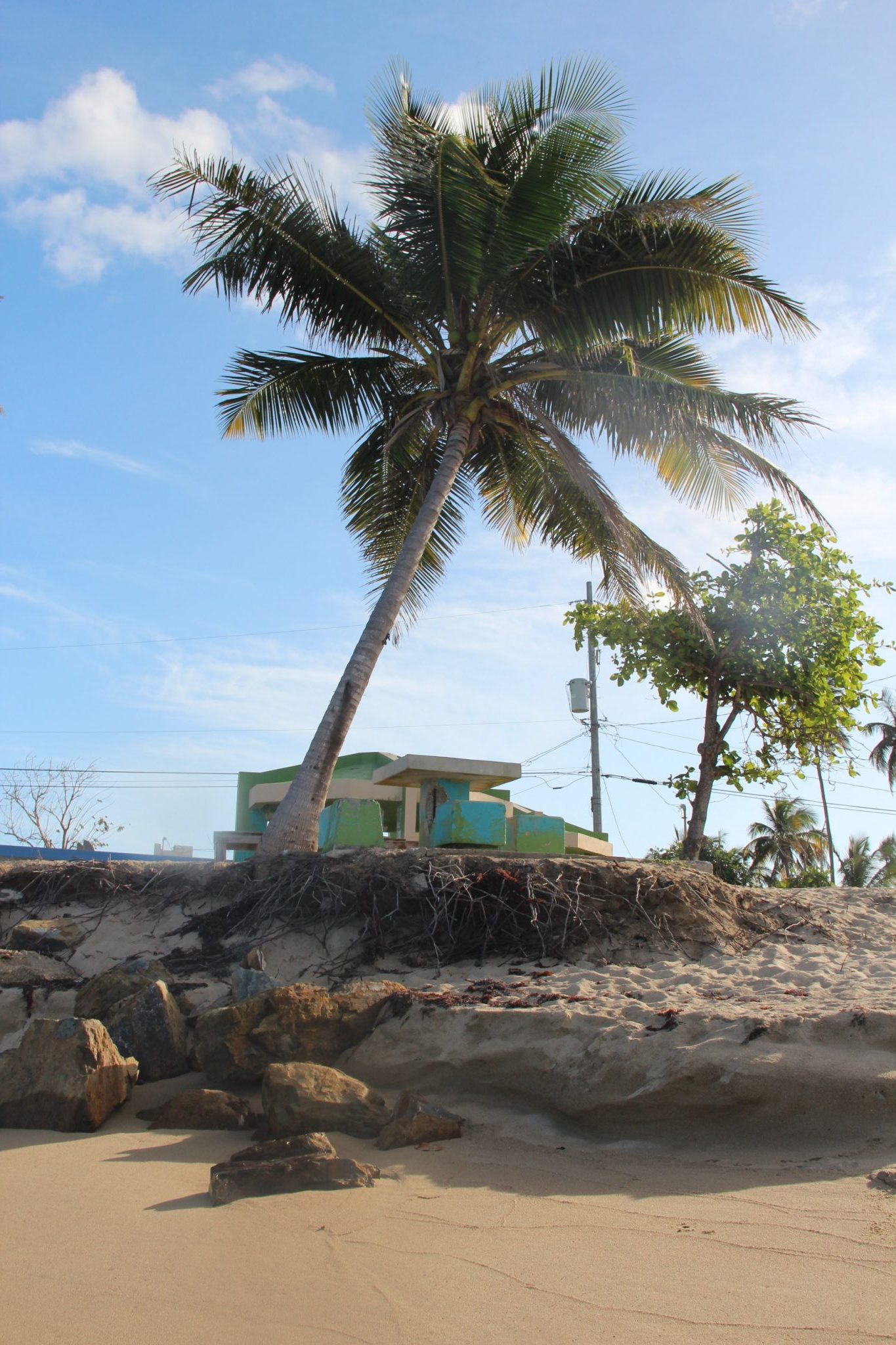

Extreme beach erosion at Parcelas Suárez. (Photo by Kari Lydersen)
Parcelas Suárez residents and Loíza mayor Julia Nazario have long felt that the Army Corps was leaving residents out of the process and making decisions without seeking their input or informing them, with planned public meetings canceled and delayed. Nazario said she would like to explore dune rebuilding and other options. “If I had money, I would have looked at mountains of different proposals,” she said. “But I don’t have money, so I have to convince the Army Corps to look for other options.”
Nazario said last spring that she would only consent to an erosion control plan approved by the community. For years, residents felt caught between skepticism of the Army Corps’ plans, frustration at the lack of information, and desperation for something to happen to protect them.
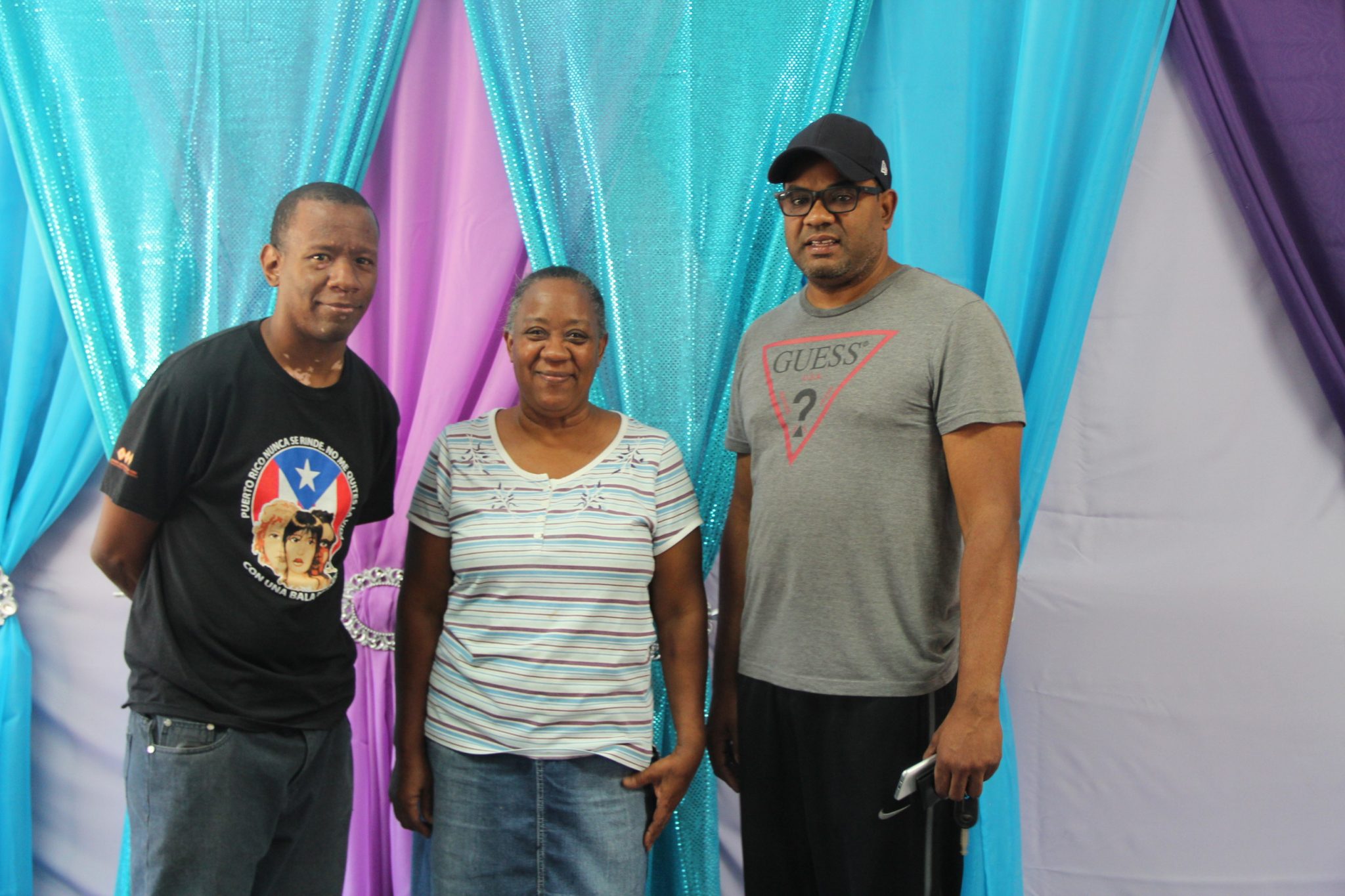

Alexis Correa Allende, Evelyn Allende and Guillermo Carmona in Parcelas Suárez. (Photo by Kari Lydersen)
“They study and study,” and don’t do anything, said Evelyn Allende, who grew up in Parcelas Suárez six decades ago and still lives here. “How long are they going to study? For a poor community like Loíza, we see this as discrimination, all this bureaucracy.”
Hard Choices
In July, the Corps released a proposal updating its April 2018 plan, and noted that erosion had become so much worse in the past year that the rock barrier will need to cover a greater area of beach than previously planned. The Corps said that without a barrier, the beachfront road and the community center and adjacent building will be destroyed, and residents will be at risk. An educational graphic included in the Army Corps’ 2018 draft plan shows the results if “no action” is taken—a home enveloped by a towering wave.
On July 17, a community meeting was finally held where the Corps presented its plans and promised that construction will start in January 2020. Army Corps spokesperson Catalina Carrasco said that the $5.17 million for the project has been appropriated and is available for work to begin.
Nazario said residents feel they have no choice now but to let the Army Corps move forward, given the situation made only more dire by near misses like Hurricane Dorian in September. But she and residents are upset that the Army Corps plan prioritizes protecting the former community center and adjacent structures, and the planned rock wall doesn’t extend far enough to protect the beach in front of a number of private homes. The community center and other buildings are already destroyed, she noted, yet the slow-moving, bureaucratic Army Corps project seems to place more value on them than homes where people still live.
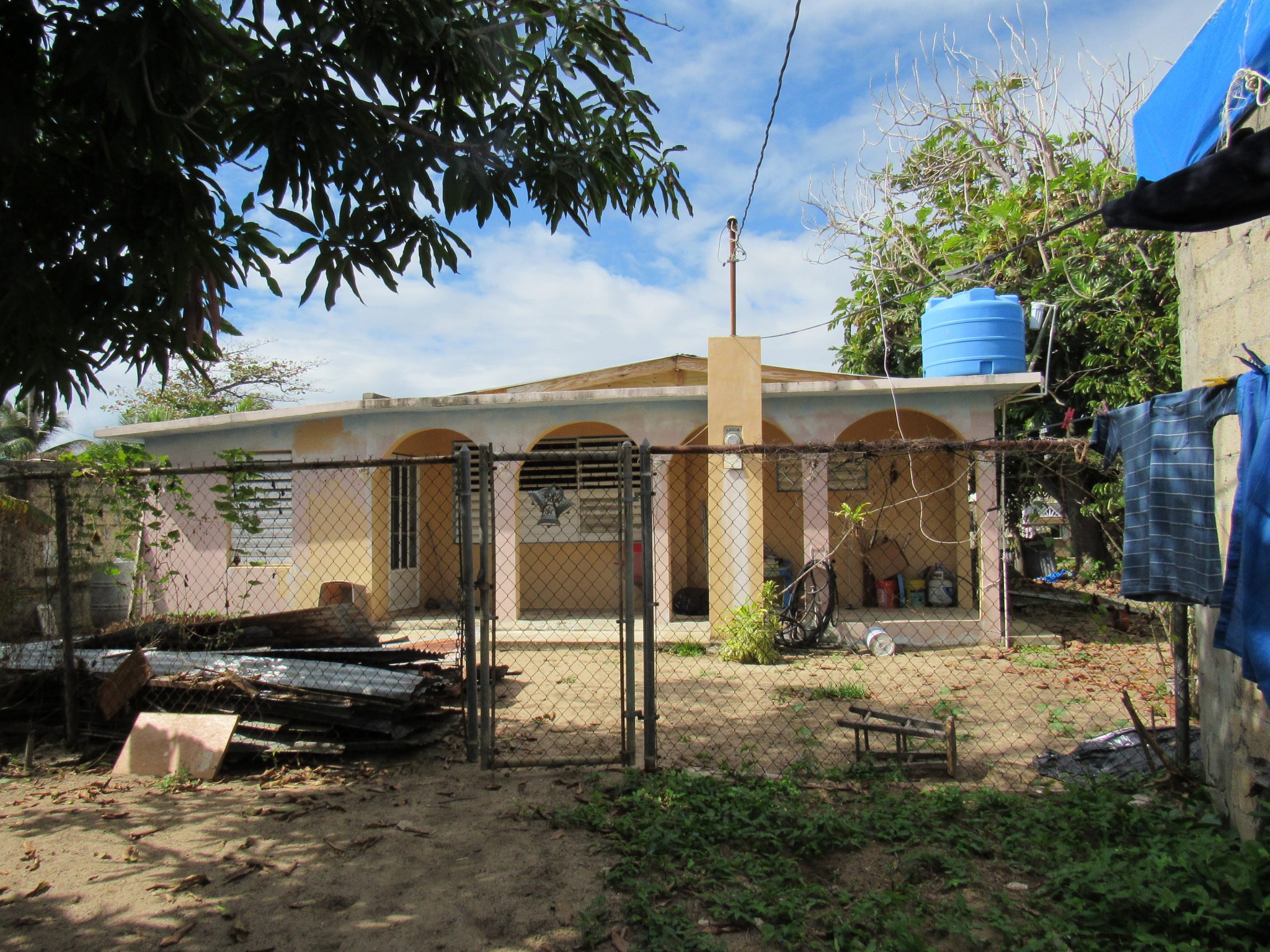

Carmona’s home, before repairs took place. (Photo courtesy of the authors)
“I explained the situation to the residents, and coordinated the meeting between the Army Corps of Engineers and community members,” Nazario said. “I explained what my worries were for this project, but I also have to say, we have to start somewhere.” Now, the goal of Nazario’s administration is to identify funds that will allow the project to expand so the rock-wall can protect the residential area of Parcelas Suárez as well.
Maritza Barreto, a marine ecologist from the University of Puerto Rico Río Piedras who has studied erosion island-wide, said it’s important that the Army Corps project not happen in isolation. She has recommended that any solution be expanded to cover Villa Cristiana and Villas del Mar, adjacent communities with erosion that could even be made worse by the Parcelas Suárez rock wall.
“The erosion there is more severe than Parcelas Suárez, and socioeconomically and demographically, the social vulnerability is worse,” she said.
She said federal, state and municipal agencies need to work together with communities to come up with comprehensive solutions that are integrated with policy, like zoning, and that in some cases land use must be revised so that buildings are not continually rebuilt in vulnerable areas. She said she’s observed that in Parcelas Suárez, as in other places she’s studied, the beach may actually be “migrating” with sand moving further inland.
While erosion makes the beachfront areas of Parcelas Suárez and other communities more vulnerable to flooding, Loíza residents further inland are also at risk. Most of Loíza sits within what FEMA designates a flood zone, and while surges from the ocean could flood Parcelas Suárez and nearby communities, swollen rivers could inundate communities throughout Loíza.
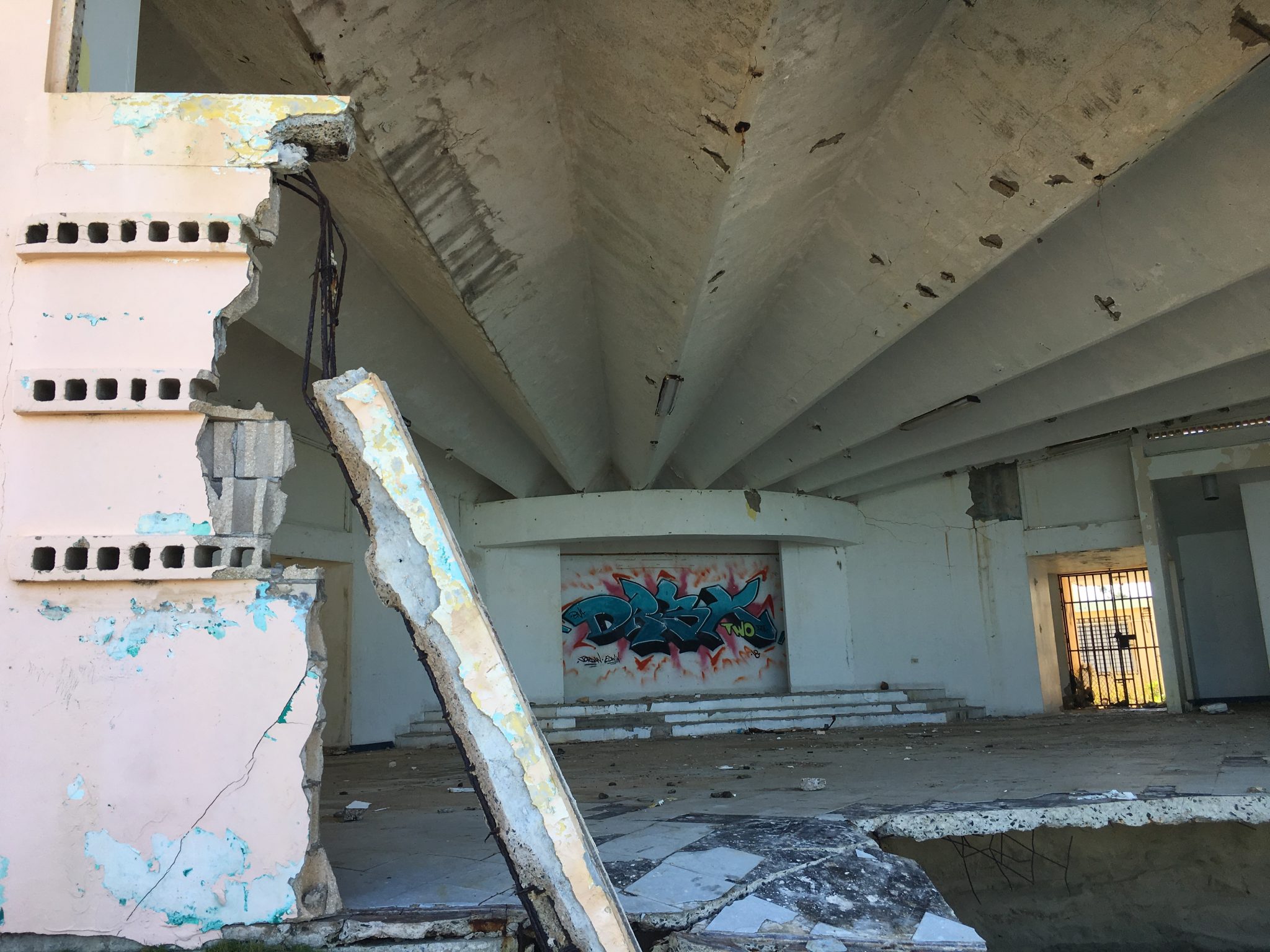

A damaged community center the approved rock wall was supposed to protect. (Photo courtesy of the authors)
The Army Corps has proposed a separate $250 million plan to prevent flooding that could endanger 5,000 families in the 310-square-mile Río Grande de Loíza basin, which includes Loíza and other towns. The Corps proposes to canalize the Río Bairoa and Río Cagüitas rivers and build levees along the Río Grande de Loíza and Río Gurabo. But money has not been authorized for that plan, according to Carrasco, and it is part of a massive backlog of proposed Army Corps flood control projects nationwide for which funding has not been secured.
If Loíza residents’ homes are severely damaged by flooding or storms, it’s highly likely they’ll have to move. Federal CDBG grants now being distributed for recovery from Hurricanes María and Irma in most cases do not allow people to get aid to rebuild in flood zones. Vivienda, the island’s housing authority, has already been proposing to relocate about 20 Parcelas Suárez households living along the beach, according to Nazario.
Antonia López, 84, has lived on the beachfront in Parcelas Suárez for 60 years. When her house was built, she says, the beach was separated from the road and its strip of ocean-facing homes by a palm grove. “We had to walk a long way to go bathe in the water,” she said.
Now, the palms are gone, and the ocean “is eating the sand fast, so fast.” During María, her house was inundated with water, and sand piled up outside. Even without a storm, notes her daughter Elizabeth, sometimes the water rises as much as 20 feet.
“I have tremendous fear,” López said. “I want to die, but I don’t want to die like that.” But still, she, like many elderly residents, does not want to leave.
“They were born there, their children were born there,” said Nazario. “To take people away from there is psychological and emotional for them. You have to respect that.”
Disparities?
Erosion from waves and storms is a crisis in various parts of the island, including the surfing mecca of Rincón on the west coast and the relatively upscale neighborhood of Ocean Park in San Juan. A recent story in Primera Hora newspaper quoted Puerto Rico natural resources official Jorge Díaz saying that 60 percent of the island’s 1,225 beaches show severe signs of erosion. Ocean Park in August sought a declaration of emergency that can help with instituting erosion mitigation measures, and the Army Corps of Engineers is studying measures to take there. The Army Corps process is further along in Parcelas Suárez, but since there are no hotel companies, wealthy residents or powerful public officials to push such measures there, some fear they will see the same disparity in erosion control that has been seen in aid and investment for rebuilding after the hurricanes.
Throughout Parcelas Suárez and nearby communities, homes are still badly damaged from the hurricanes and blue tarps still cover roofs. FEMA granted aid to cover just over 60 percent of total hurricane damage, by dollar amount, in the region of Loíza, according to an analysis of FEMA data. $10.6 million in FEMA aid was approved, with total damage pegged at $17 million, according to the data. The San Juan area, by contrast, got about $33 million in aid according to the same data.
Carmona’s house just off the beach was made unlivable by the hurricanes. During a January visit, he walked through the rooms pointing out exposed ceiling beams, buckled floors and damaged drywall. He and his wife had lived there since their marriage in 2003, and the home had been in his family for years before that. Their belongings were stacked in corners, and the water-stained walls still displayed proud mementos: a certificate for helping during an oil refinery explosion, another celebrating his church “baptism by water.” Carmona’s 8-year-old daughter’s room had butterflies on the walls and “Te Amo Dariana, Tu Papa” (“I love you Dariana, Your Papa”) inscribed in the concrete door jam.
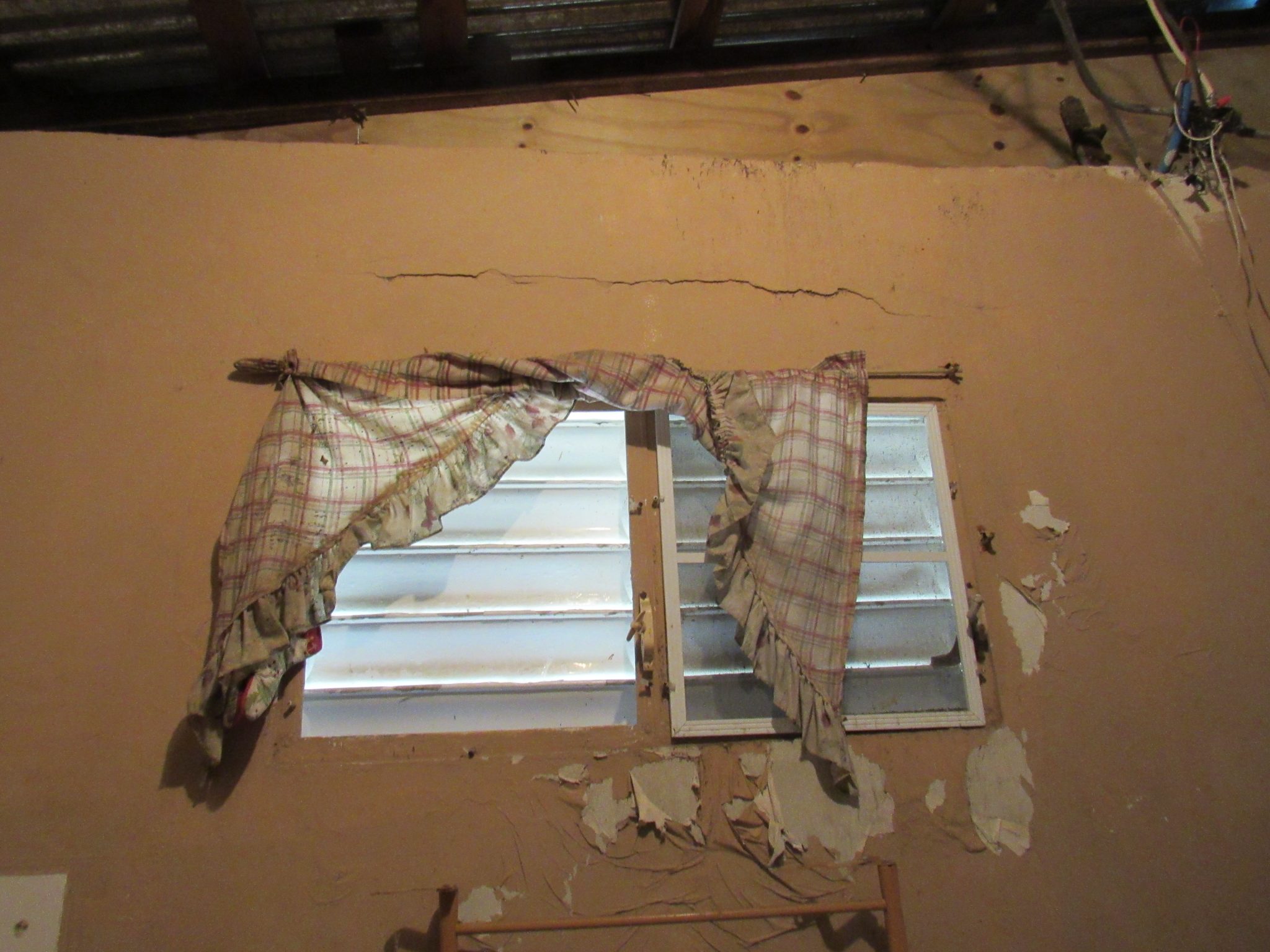

Carmona’s home, pre-repairs. (Photo courtesy of the authors)
Carmona had hoped to move into a development of brightly painted, modern stucco homes just inland of Parcelas Suárez, built with funding from an anonymous donor subsidizing $50,000 of the $80,000 asking price for each unit. But those aspiring to move in were required to get a $30,000 mortgage from Banco Popular, Carmona explained, and since his wife had no credit they were found ineligible. During the January visit, the homes were finished but almost entirely unoccupied—an example of the bureaucratic snafus and inertia that have exacerbated recovery in many parts of the island.
If Parcelas Suárez residents are unable to rebuild their homes or suffer damage from future hurricanes, they may take the route many have already: leaving Parcelas Suárez for other parts of the island, or leaving the island altogether. But that is a drastic and painful move for the many families who have lived here for generations, since the land was allotted to people displaced from the interior in the mid-1900s under Operation Bootstrap—a sweeping plan imposed to industrialize the agricultural economy.
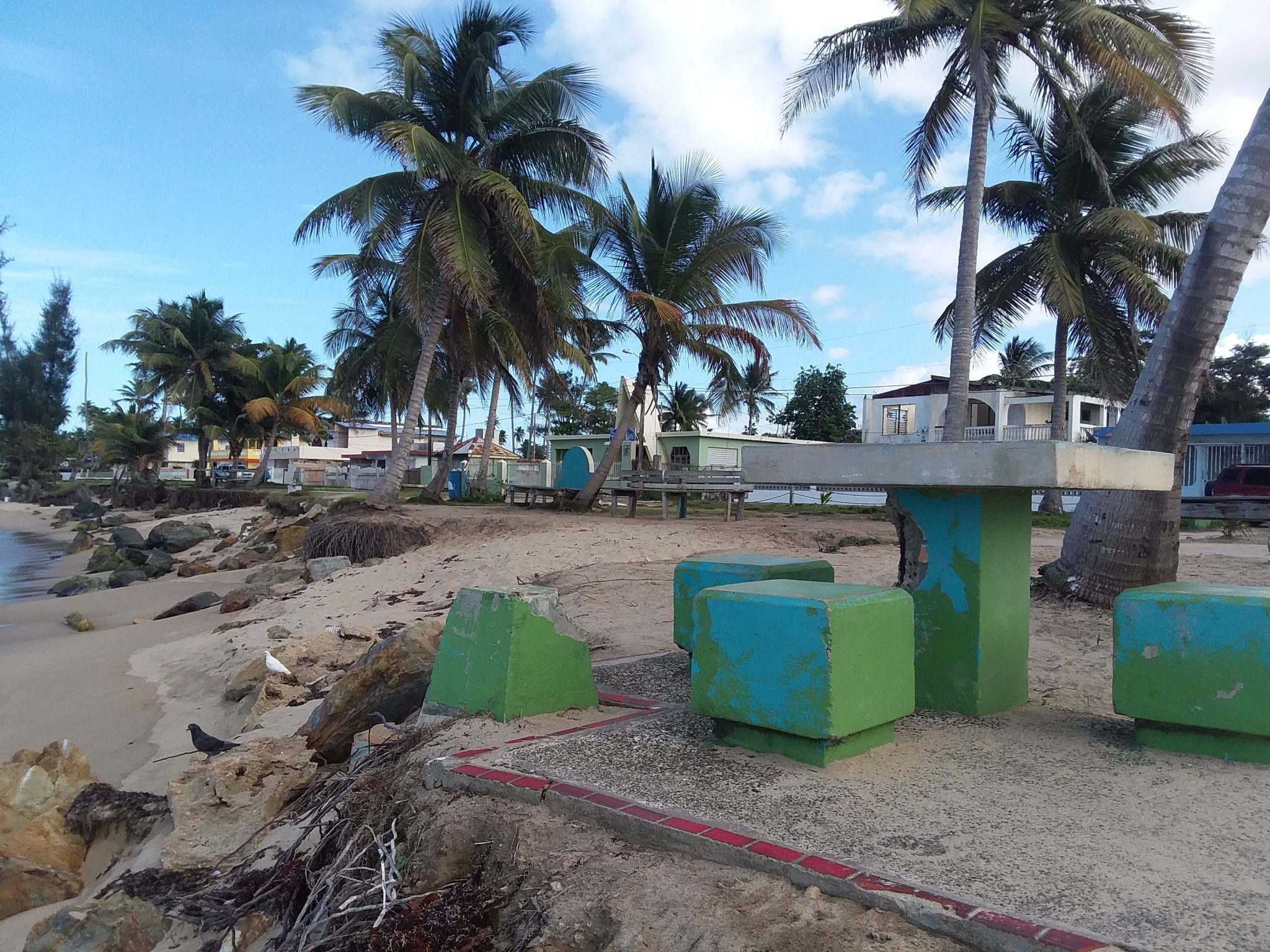

Erosion on the beach in Parcelas Suárez. (Photo by Kari Lydersen)
The median household income in Loíza (which includes Parcelas Suárez) is less than $12,000 compared to $19,000 island-wide (and $60,000 in the U.S. as a whole). The community is a short drive from wealthy areas of San Juan, and some wonder if developers and public officials would like to see the community uprooted to make way for tourist hotels and more upscale development. But residents are determined to hold on.
Fighting to Rebuild and Remain
In 2016, the local school in Parcelas Suárez was closed, one of the more than 300 schools across the island shuttered in recent years as a result of population loss and the fiscal crisis. But residents refused to lose the community anchor, and occupied the closed school. Alexis Correa Allende, leader of the community organization Centro Comunitario Gregorio, remembers a night-time stand-off when police stormed in.
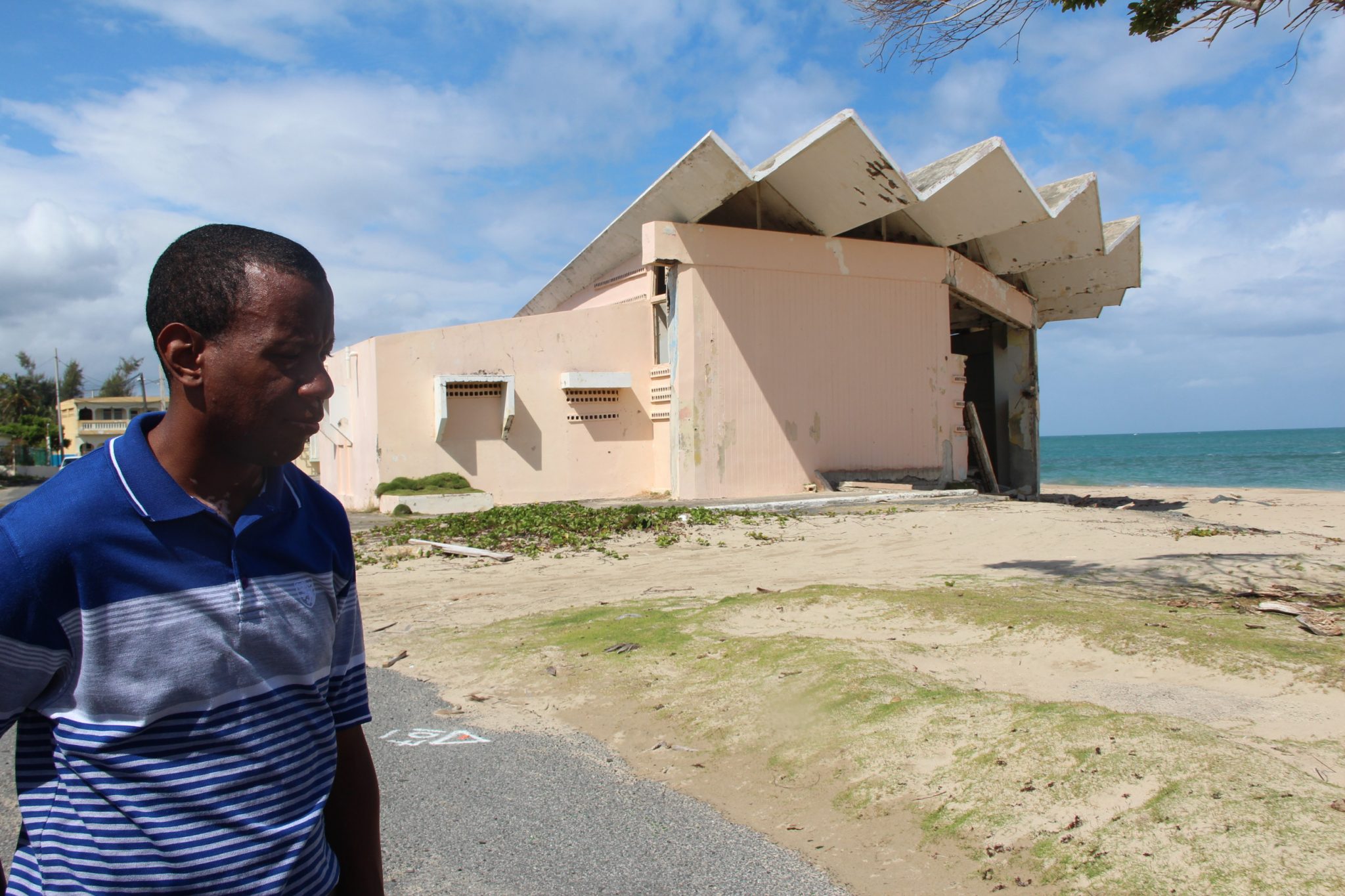

Alexis Correa Allende and the destroyed community center on the beach in Parcelas Suárez. (Photo by Kari Lydersen)
After that, community leaders negotiated with officials and eventually won the right to reopen the closed school as a community center.
Today they run a Head Start program and various other programs out of the building. One former classroom is full of clothes and shoes available for residents in need. A water purification system, donated after the hurricane, sits in the courtyard. One day in February, community leaders held a health fair, where government health officials, NGOs and a solar energy company offered advice and resources to residents, while Evelyn Allende —Alexis’ mother— served steaming plates of rice and stew.
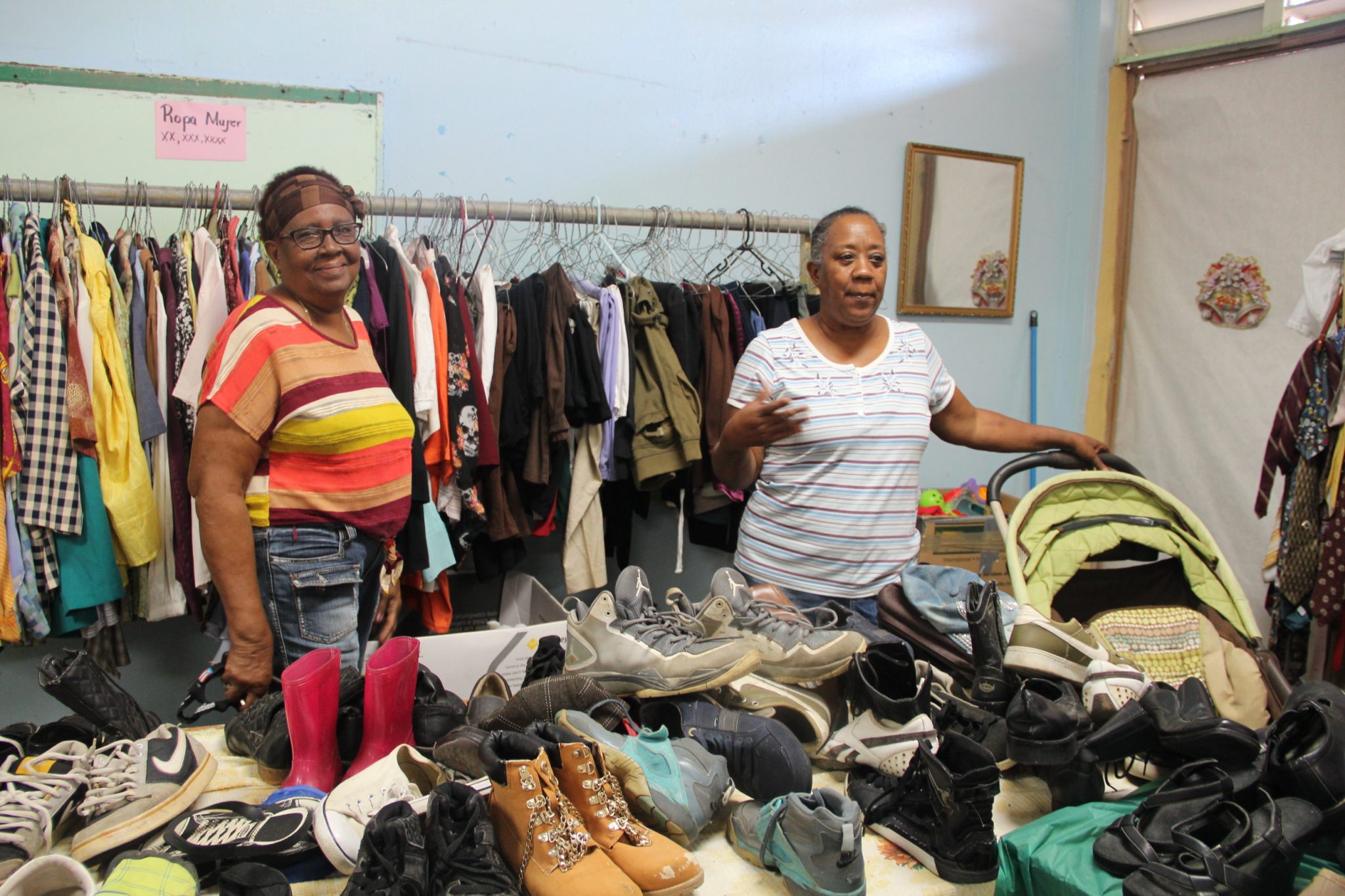

Community leaders distribute free clothing and more at the closed school transformed into a community center in Parcelas Suárez. (Photo by Kari Lydersen)
The wide, gnarled tree providing precious shade in the school’s courtyard is more than a century old, Allende noted. She reminisced about attending the school herself as a child in the 1960s. Many of her former classmates have passed away, or fallen victim to drug addiction. But some are still working alongside her.
Even before the government officially granted the community rights to the school, residents spent hours pitching in to scrub the patio, trim the tree, fix the roof. They’ve also recruited lawyers to help people seeking FEMA aid, connected locals with medical help, served food, celebrated Mother’s and Father’s Day and the Day of the Child.
“Everything depends on us, not the government,” said Evelyn Allende, in Spanish. “Little by little we’re becoming re-established, [going] back to normal.”
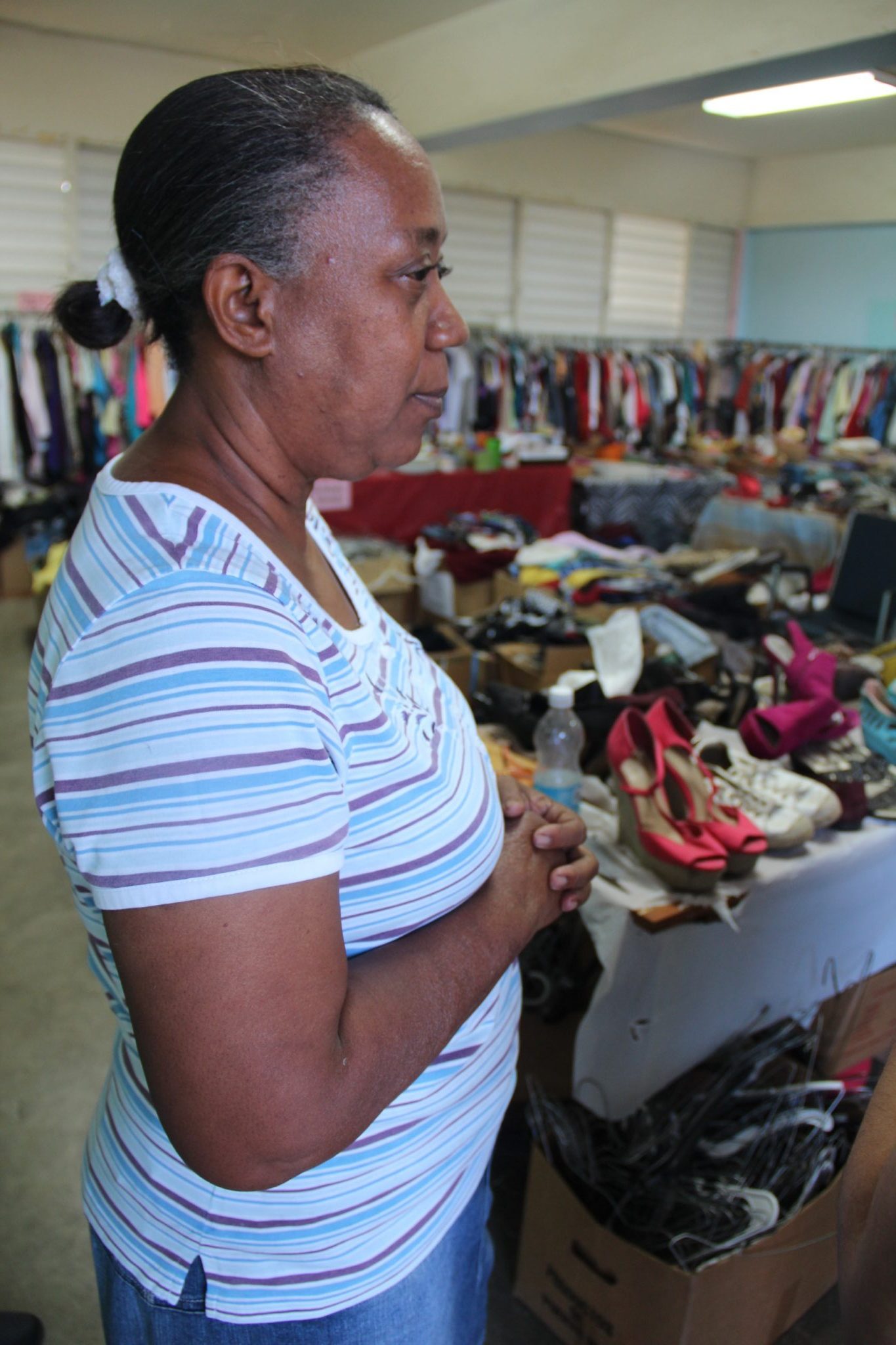

Evelyn Allende in the clothing center at the Parcelas Suárez community center. (Photo by Kari Lydersen)
The cohesion that residents built around the battle to save the school could be crucial to helping them save the community as a whole, starting with the eroding beachfront.
“The fight for the school built more power, more energy,” said Correa, in Spanish. “We continue fighting, the struggle continues.”
Today Carmona and his family are back in their home near the damaged community center. That’s thanks to a grant from the Ricky Martin Foundation, which helped them rebuild. The home could be destroyed by flooding in a future storm surge, though Carmona notes that the hulk of the community center actually affords some protection.
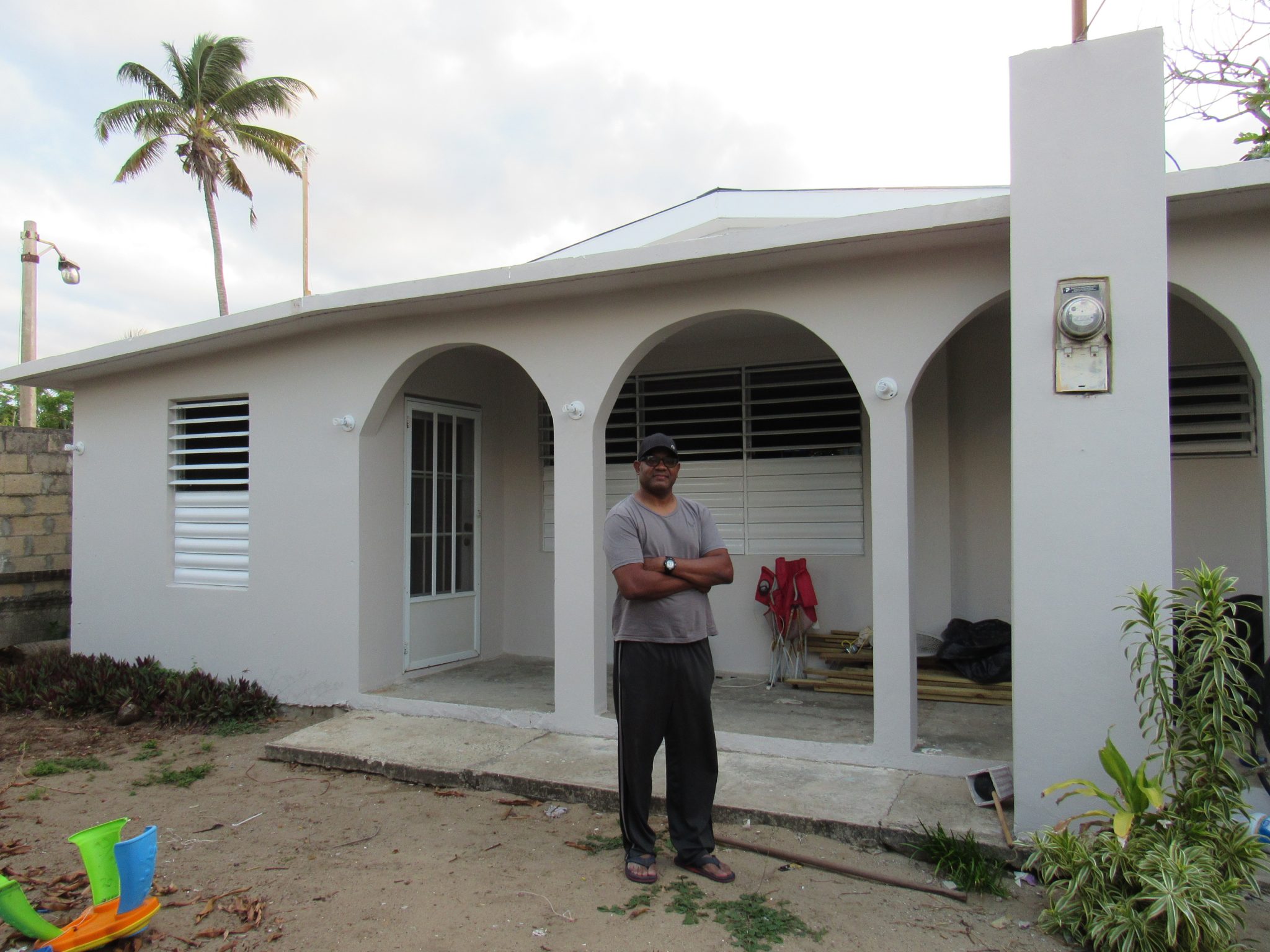

Guillermo Carmona after his home was repaired by the Ricky Martin Foundation. (Photo courtesy of the authors)
The situation of Parcelas Suárez could be seen as symbolic of the struggles of many communities in Puerto Rico, and the history of resistance that reached a boiling point this summer with the massive protests that ousted Governor Ricardo Rosselló and continue to demand wholesale political and economic change.
Puerto Ricans have had to develop resiliency over decades in the face of colonialism, poverty, and racism, developing strong community networks as government bureaucracies, physical structures and the very land erode around them.
“I have much faith in the people here in Loíza,” said Carmona, against the roar of crashing waves. “This is a community who studies, who works. Nothing is impossible.”
***
Isabel Dieppa is a journalist based in Chicago. She frequently writes about comics, music, Puerto Rico, feminism and politics. You can read some of her reporting at Reuters PLACE, PRI/The World, Remezcla, Centro de Periodismo Investigativo (CPI), Marie Claire, Bust and Bustle. Dieppa is the recipient of a 2018 Pulitzer Center on Crisis Reporting grant.
Kari Lydersen is a Chicago-based journalist and author who teaches and leads the Social Justice & Investigative specialization in the graduate journalism program at Northwestern University.
Martha Bayne is a Chicago freelance journalist and a senior editor with Belt Publishing. Her work has appeared in the Chicago Reader, the Chicago Reporter, the Baffler, Belt Magazine, Eater, PRI/The World, and the Centro de Periodismo Investigativo (CPI).
Support for this story was provided by the Pulitzer Center.



[…] 17-year-old Paula Candelaria said. “And we don’t have to go through what the Parcela community did. So those of us with the privilege of not going through that have to see how to […]